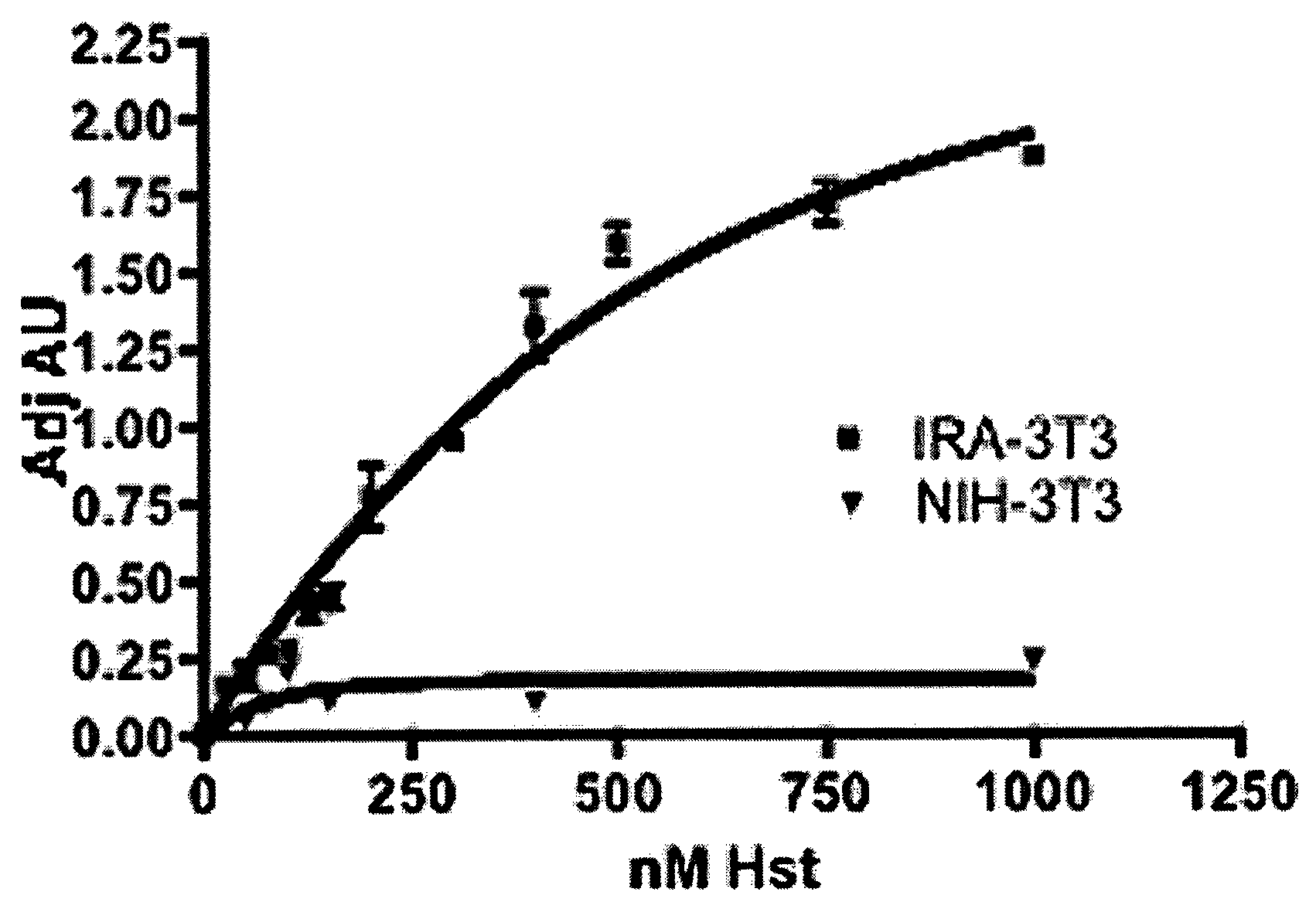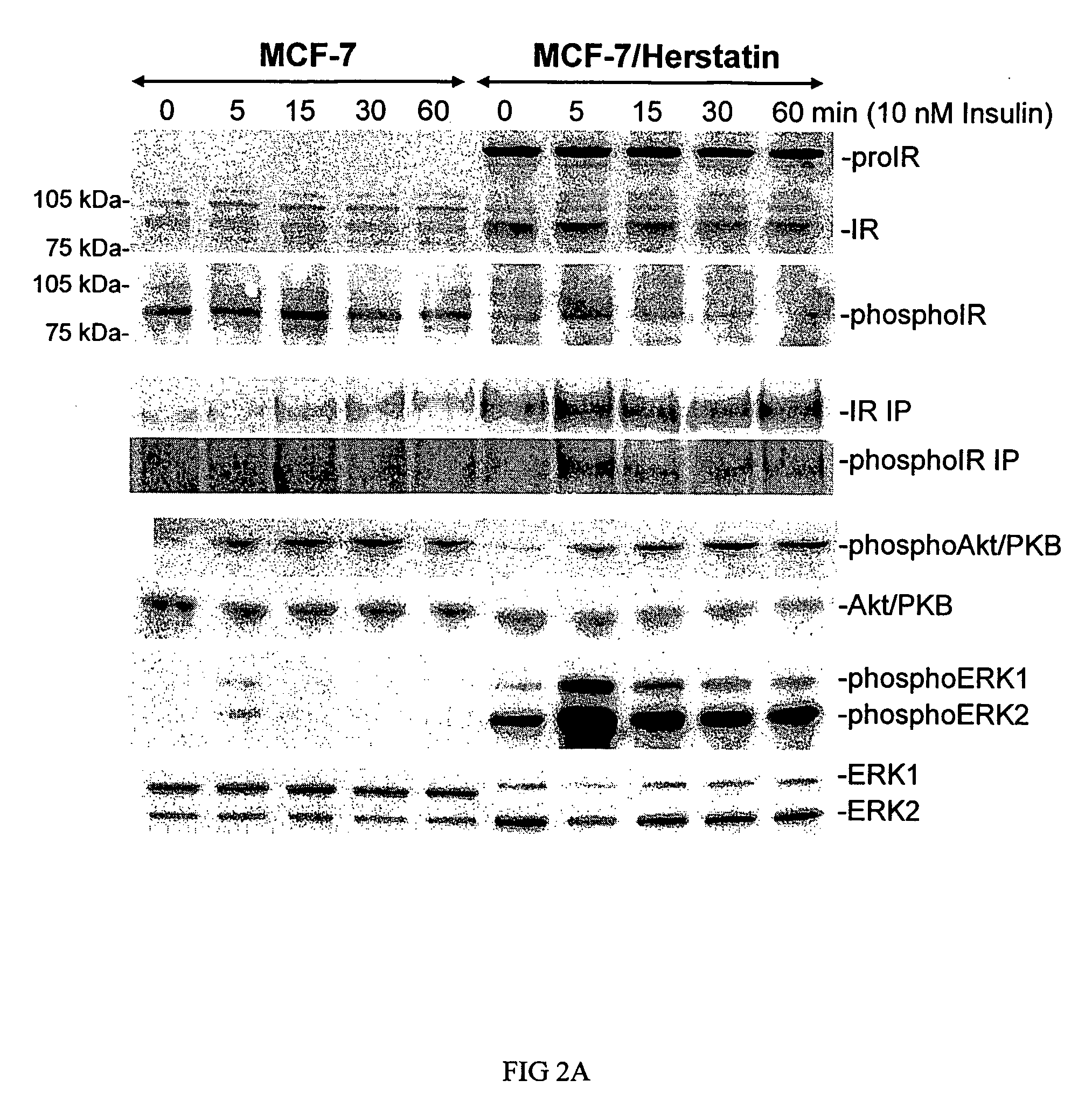Compositions and Methods for Treating Disease
a technology of compositions and methods, applied in the field of therapeutic molecules, can solve the problems of low ir expression, and low ir-mediated erk pathway activation rate, and achieve the effect of increasing the ir-mediated erk pathway activation and positive effect on ir expression
- Summary
- Abstract
- Description
- Claims
- Application Information
AI Technical Summary
Benefits of technology
Problems solved by technology
Method used
Image
Examples
example i
Materials and Methods
Cell Lines, Transfections, Expression Vectors, Western Blots and Antibodies
[0137]Cell lines. IRA-3T3 (3T3 cells transfected with a human insulin receptor cDNA have been previously described (Faria et al., J. Biol. Chem. 269:13922-13928 (1994)), and Herstatin-expressing MCF-7 cell clones were obtained using previously described methods (Shamieh et al., FEBS Letters, 568:163-166, 2004).
[0138]Transfections. For transient transfections, 2 μg of empty vector or 2 μg expression vector are added with Lipofectamine™ (GIBCO-BRL) to cells in 6 cm plates.
[0139]Western blot analysis, and antibodies. For Western blot analyses, whole-cell lysates or immunoprecipitated proteins were resolved by SDS-PAGE and transferred onto nitrocellulose membranes (BioRad, Hercules, Calif.). Blots were blocked in 5% milk and incubated with primary antibody overnight at 4° C. The antibodies included anti-insulin receptor (IR; against the β subunit), anti-IGF-IR, anti-IRS-1, anti-IRS-2, anti-ph...
example ii
Herstatin was Shown to Bind Specifically to Insulin Receptor (IR) with nM Binding Affinity
[0147]The interaction of Herstatin with IR in transfected 3T3 cells (IRA-3T3) was investigated. Herstatin bound specifically to IR at nM concentrations, and IR was thus shown herein to be a target of Herstatin.
[0148]Methods. Cell lines, expression vectors, protein purification, pull down assays, antibodies, Western blot analysis and ELISA assays were as described under EXAMPLE I, herein above.
[0149]Results. The interaction between Herstatin and IR was investigated. FIG. 1 shows that Herstatin, purified from transfected S2 insect cells, exhibited dose-dependent binding to IR at nM concentrations. Increasing concentrations of Herstatin, expressed and purified from stably-transfected S2 insect cells, were added to 3T3 parental cells (filled triangles; “NIH-3T3”) or 3T3 cells transfected with a human IR cDNA (filled squares; “IRA-3T3”) as previously described (Shamieh et al., FEBS Letters, 568:163-...
example iii
Herstatin Up-regulated Insulin Receptor (IR) Expression, and Activation of IR by Insulin in MCF-7 Cells
[0151]According to particular embodiments of the present invention, Herstatin not only up-regulates IR expression, but also up-regulates activation of IR by insulin (FIG. 2).
[0152]Methods. Cell lines, expression vectors, protein purification, pull down assays, antibodies, Western blot analysis and ELISA assays were as described under EXAMPLE I, herein above. Insulin was added either to MCF-7 breast carcinoma cells, or to an MCF-7 cell line stably transfected with a Herstatin expression vector, to determine whether Herstatin expression affects IR expression, and / or insulin-stimulated IR signal transduction.
[0153]Results. FIG. 2 shows that Herstatin expression not only up-regulated IR expression (including pro-IR), but also up-regulated IR activation (and thus signaling) in MCF-7 cells. Control and Herstatin-expressing MCF-7 cells were grown in complete medium prior to an overnight i...
PUM
| Property | Measurement | Unit |
|---|---|---|
| affinity binding constant | aaaaa | aaaaa |
| affinity binding constant | aaaaa | aaaaa |
| affinity binding constant | aaaaa | aaaaa |
Abstract
Description
Claims
Application Information
 Login to View More
Login to View More - R&D
- Intellectual Property
- Life Sciences
- Materials
- Tech Scout
- Unparalleled Data Quality
- Higher Quality Content
- 60% Fewer Hallucinations
Browse by: Latest US Patents, China's latest patents, Technical Efficacy Thesaurus, Application Domain, Technology Topic, Popular Technical Reports.
© 2025 PatSnap. All rights reserved.Legal|Privacy policy|Modern Slavery Act Transparency Statement|Sitemap|About US| Contact US: help@patsnap.com



